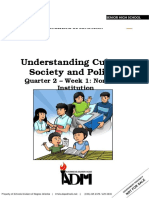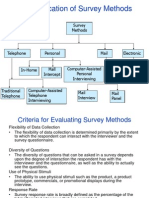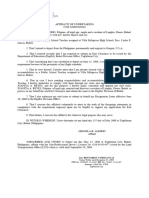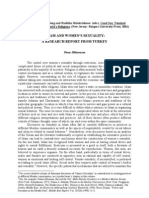Professional Documents
Culture Documents
Q2m3-Group 3
Q2m3-Group 3
Uploaded by
Jean Rose GentizonOriginal Title
Copyright
Available Formats
Share this document
Did you find this document useful?
Is this content inappropriate?
Report this DocumentCopyright:
Available Formats
Q2m3-Group 3
Q2m3-Group 3
Uploaded by
Jean Rose GentizonCopyright:
Available Formats
lOMoARcPSD|22986438
Intro-to-World-Religions and Belief Systems-Q2-3
World Religion (Mabini National High School)
Scan to open on Studocu
Studocu is not sponsored or endorsed by any college or university
Downloaded by Jean Rose Gentizon ([email protected])
lOMoARcPSD|22986438
12
12
Introduction to World
Religions and Belief Systems
Quarter 2 – Module 11:
Comparative Analysis of Mahayana and
Theravada Buddhism
Downloaded by Jean Rose Gentizon ([email protected])
lOMoARcPSD|22986438
Introduction to World Religions and Belief Systems – Grade 12
Alternative Delivery Mode
Quarter 2 – Module 11: Comparative Analysis of Mahayana and Theravada
Buddhism
First Edition, 2020
Republic Act 8293, section 176 states that: No copyright shall subsist in any
work of the Government of the Philippines. However, prior approval of the government
agency or office wherein the work is created shall be necessary for exploitation of such
work for profit. Such agency or office may, among other things, impose as a condition
the payment of royalties.
Borrowed materials (i.e., songs, stories, poems, pictures, photos, brand names,
trademarks, etc.) included in this module are owned by their respective copyright
holders. Every effort has been exerted to locate and seek permission to use these
materials from their respective copyright owners. The publisher and authors do not
represent nor claim ownership over them.
Published by the Department of Education
Secretary: Leonor Magtolis - Briones
Undersecretary: Diosdado M. San Antonio
Development Team of the Module
Writer: Laurice Kathe T. Inso
Editors: Catherine A. Credo/Jiosel C. Tuballa
Reviewers: Divina May S. Medez
Illustrator: Typesetter
Layout Artist: Vanesa R. Deleña
Management Team: Senen Priscillo P. Paulin, CESO V Rosela R. Abiera
Fay C. Luarez, TM, Ed.D., Ph.D. Maricel S. Rasid
Nilita L. Ragay, Ed.D. Elmar L. Cabrera
Carmelita A. Alcala, Ed.D.
Printed in the Philippines by ________________________
Department of Education –Region VII Schools Division of Negros Oriental
Office Address: Kagawasan, Ave., Daro, Dumaguete City, Negros Oriental
Tele #: (035) 225 2376 / 541 1117
E-mail Address: [email protected]
Downloaded by Jean Rose Gentizon ([email protected])
lOMoARcPSD|22986438
12
Introduction to
World Religions
and Belief
Systems
Quarter 2 – Module 11
Comparative Analysis of
Mahayana and Theravada
Buddhism
Downloaded by Jean Rose Gentizon ([email protected])
lOMoARcPSD|22986438
Introductory Message
For the facilitator:
Welcome to the Introduction to World Religions and Belief Systems – 12
Alternative Delivery Mode (ADM) Module on Comparative Analysis of
Mahayana and Theravada Buddhism!
This module was collaboratively designed, developed and reviewed by
educators both from public and private institutions to assist you, the teacher
or facilitator in helping the learners meet the standards set by the K to 12
Curriculum while overcoming their personal, social, and economic
constraints in schooling.
This learning resource hopes to engage the learners into guided and
independent learning activities at their own pace and time. Furthermore, this
also aims to help learners acquire the needed 21st century skills while taking
into consideration their needs and circumstances.
In addition to the material in the main text, you will also see this box in the
body of the module:
Notes to the Teacher
This contains helpful tips or strategies that
will help you in guiding the learners.
As a facilitator, you are expected to orient the learners on how to use this
module. You also need to keep track of the learners' progress while allowing
them to manage their own learning. Furthermore, you are expected to
encourage and assist the learners as they do the tasks included in the module.
ii
Downloaded by Jean Rose Gentizon ([email protected])
lOMoARcPSD|22986438
For the learner:
Welcome to the Introduction to World Religions and Belief System-
Grade 12 Alternative Delivery Mode (ADM) Module on Comparative Analysis
of Mahayana and Theravada Buddhism!
This module was designed to provide you with fun and meaningful
opportunities for guided and independent learning at your own pace and time.
You will be enabled to process the contents of the learning resource while
being an active learner.
This module has the following parts and corresponding icons:
This will give you an idea of the skills or
What I Need to Know competencies you are expected to learn in the
module.
This part includes an activity that aims to
check what you already know about the
What I Know
lesson to take. If you get all the answers
correct (100%), you may decide to skip this
module.
This is a brief drill or review to help you link
What’s In the current lesson with the previous one.
In this portion, the new lesson will be
What’s New introduced to you in various ways; a story, a
song, a poem, a problem opener, an activity
or a situation.
This section provides a brief discussion of the
What is It lesson. This aims to help you discover and
understand new concepts and skills.
This comprises activities for independent
practice to solidify your understanding and
What’s More
skills of the topic. You may check the
answers to the exercises using the Answer
Key at the end of the module.
This includes questions or blank
What I Have Learned sentence/paragraph to be filled in to process
what you learned from the lesson.
This section provides an activity which will
What I Can Do help you transfer your new knowledge or skill
into real life situations or concerns.
iii
Downloaded by Jean Rose Gentizon ([email protected])
lOMoARcPSD|22986438
This is a task which aims to evaluate your
Assessment level of mastery in achieving the learning
competency.
In this portion, another activity will be given
Additional Activities to you to enrich your knowledge or skill of the
lesson learned.
Answer Key This contains answers to all activities in the
module.
At the end of this module you will also find:
References This is a list of all sources used in
developing this module.
The following are some reminders in using this module:
1. Use the module with care. Do not put unnecessary mark/s on any part
of the module. Use a separate sheet of paper in answering the exercises.
2. Don’t forget to answer What I Know before moving on to the other
activities included in the module.
3. Read the instruction carefully before doing each task.
4. Observe honesty and integrity in doing the tasks and checking your
answers.
5. Finish the task at hand before proceeding to the next.
6. Return this module to your teacher/facilitator once you are through
with it.
If you encounter any difficulty in answering the tasks in this module, do
not hesitate to consult your teacher or facilitator. Always bear in mind that
you are not alone.
We hope that through this material, you will experience meaningful
learning and gain deep understanding of the relevant competencies. You
can do it!
iv
Downloaded by Jean Rose Gentizon ([email protected])
lOMoARcPSD|22986438
What I Need to Know
Good day, this is Teacher Tina. How are you?
In Theravada and Mahayana Buddhism, the concept of
dharma is an integral tenet. Do you know what dharma is?
Don’t worry if you have no idea what it is. This module is
here to help you understand this concept and many others.
Ready? Then, let’s begin.
https://bit.ly/2CTRcJs
MOST ESSENTIAL LEARNING COMPETENCY:
Explain the uniqueness and similarities of Mahayana and Theravada Buddhism
At the end of the module, you should be able to:
K: Identify the similar features of Theravada and Mahayana Buddhism;
S: Conduct a comparative analysis of the two major Buddhism sects ; and
A: show appreciation to the differences and similarities of the two religions/belief
systems.
Downloaded by Jean Rose Gentizon ([email protected])
lOMoARcPSD|22986438
What I Know
Directions: Write T if the statement is TRUE, and F if it is FALSE. Write your
answers in your activity notebook.
1. Both Theravada and Mahayana Buddhism, trace their origin in China.
2. Buddhism is founded by Siddhartha Gautama who is also referred to as the
Buddha or the <Enlightened One.=
3. The two major schools of Buddhism, the Theravada and Mahayana sects,
follow the <Four Noble Truths= and the <Noble Eightfold Path.=
4. Buddhist followers, life and events are controlled by an all-powerful creator or
universal force.
5. A person who has attained a perfected state of insight is called bodhisattvas
or <enlightened beings= in Theravada school of Buddhism.
6. Arhat or a <worthy person= in Mahayana sect, delay their own fulfillment for
them to benevolently aid other beings to reach their ultimate end.
7. The Buddhist goal is to reach nirvana or the extinguishing of fires of longing
and suffering.
8. Theravada Buddhism offers enlightenment to anyone, including those with
families and secular careers.
9. A Buddhist’s destiny is the direct result of natural law or dharma and one’s
accumulated deeds or karma.
10. Women in Buddhism have enjoyed considerable freedom in their religious life
compared to their Hindus counterpart.
Downloaded by Jean Rose Gentizon ([email protected])
lOMoARcPSD|22986438
What’s In
In the previous module, we have discussed the core teachings, fundamental
beliefs, and related issues of Mahayana Buddhism. You have also learned how it
seems to have an interesting appeal to a vast majority of followers.
In this module, we will explore the connection between the two Buddhist
religions- Theravada and Mahayana Buddhism and how essential is the concept of
dharma in these two major sects of Buddhism.
What’s New
Instructions: Look at the pictures of bodhisattvas (enlightened beings) in Buddhism
below. Afterwards, be ready to accomplish the prepared activity for you.
1. Avalokiteshvara, Bodhisattva of Compassion
pa_YON / Getty Images
Avalokiteshvara represents the activity of Karuna -- compassion, active
sympathy, gentle affection. The name Avalokiteshvara is usually translated to mean
"The Lord Who Looks Down in Pity" or "The One Who Hears the Cries of the World."
2. Manjusri, Bodhisattva of Wisdom
https://creativecommons.org/licenses/by-nc-sa/3.0/
Downloaded by Jean Rose Gentizon ([email protected])
lOMoARcPSD|22986438
The name "Manjushri" (also spelled Manjusri) means "He Who Is Noble and
Gentle." This bodhisattva represents insight and awareness. Manjushri sees into the
essence of all phenomena and perceives their nondual nature. He clearly realizes the
boundless nature of self.
3. Kshitigarbha, Savior of Beings in Hell
electravk / Getty Images
Kshitigarbha (Sanskrit, "Womb of the Earth") is known as Ti-ts'sang or Dicang in China
and Jizo in Japan. He is venerated as the savior of beings in hell and as a guide to deceased
children. Kshitigarbha has vowed not to rest until he has emptied hell of all beings. He is also
the protector of living children, expectant mothers, firemen, and travelers.
4. Mahasthamaprapta and the Power of Wisdom
Elton Melo/Flickr / Creative Commons License
Mahasthamaprapta (Sanskrit, "One Who Has Obtained Great Power")
awakens in humans their need to be liberated from Samsara (the beginningless cycle
of repeated birth, mundane existence and dying again).
5. Samantabhadra Bodhisattva - Buddhist Icon of Practice
Samantabhadra Bodhisattva. dorje-d/Flickr, Creative Commons License
Downloaded by Jean Rose Gentizon ([email protected])
lOMoARcPSD|22986438
Samantabhadra (Sanskrit, "He Who Is All-Pervadingly Good") is called Fugen in Japan
and P'u-Hsien or Puxian in China. He is the protector of those who teaches the Dharma and
represents the meditation and practice of the Buddhas.
Based on the above facts about the major bodhisattvas in Buddhism, complete the
table below in your activity notebook.
Name of Bodhisattva English translation of Significance/ Power/Duty
Name
What is It
Comparative Analysis of Theravada and Mahayana Buddhism
Both the Buddhist schools originated in India. In Buddhism (Mahayana and
Theravada), dharma is an integral concept. Dharma (Sanskrit) or dhamma (Pali) is a
word Buddhists use often. It may pertain to the cosmic law and order or to Buddha’s
teachings. Apart from the Buddha and the sangha, the dharma is one of the <Three
Jewels= to which Buddhist followers go for refuge. The word often is defined as "the
teachings of the Buddha," but dharma is really more than just a label for Buddhist
doctrines, as we shall see below.
The word dharma comes from the ancient religions of India and is found in
Hindu and Jain teachings, as well as Buddhist. Its original meaning is something like
"natural law." Its root word, dham, means "to uphold" or "to support." In this broad
sense, common to many religious traditions, dharma is that which upholds the natural
order of the universe. This meaning is also part of the Buddhist understanding.
In addition, dharma supports the practice of those who are in harmony with it.
On this level, dharma refers to ethical conduct and righteousness. In some Hindu
traditions, dharma is used to mean "sacred duty." For more on the Hindu perspective
of the word dharma, see " What is Dharma?" by Subhamoy Das.
Dhamma in Theravada Buddhism
Dhamma is the nature of what-is; the truth of what the Buddha taught. In
Theravada Buddhism, as in the quote above, it is sometimes used to indicate all the
factors of existence.
Thanissaro Bhikkhu wrote that "Dhamma, on the external level, refers to the
path of practice the Buddha taught to his followers" This Dhamma has three levels of
Downloaded by Jean Rose Gentizon ([email protected])
lOMoARcPSD|22986438
meaning: the words of the Buddha, the practice of his teaching, and the attainment of
enlightenment. So, Dhamma is not just doctrines--it is teaching plus practice plus
enlightenment.
Dharma in Mahayana Buddhism
Mahayana Buddhism generally uses the word dharma to refer to both the
teachings of the Buddha and the realization of enlightenment. More often than not,
use of the word incorporates both meanings at once. Mahayana texts sometimes use
the word dharma to mean something like "manifestation of reality.=
To speak of someone's understanding of dharma is not to comment on how
well that person can recite Buddhist doctrines but on his state of realization. In the Zen
tradition, for example, to present or expound upon the dharma usually refers to
presenting some aspect of the true nature of reality.
The Dharma Body
Both Theravada and Mahayana Buddhists speak of the "dharma body"
(dhammakaya or dharmakaya). This is also called the "truth body."
Very simply, in Theravada Buddhism, a Buddha (an enlightened being) is
understood to be the living embodiment of dharma. This does not mean that a
Buddha's physical body (rupa-kaya) is the same thing as dharma, however. It's a bit
closer to it to say that the dharma becomes visible or tangible in a Buddha
In Mahayana Buddhism, the dharmakaya is one of the three bodies (tri-kaya)
of a Buddha. The dharmakaya is the unity of all things and beings, unmanifested,
beyond existence and non-existence.
In sum, the word dharma is nearly indefinable. But to the extent that it can be
defined, we can say that dharma is both the essential nature of reality and also the
teachings and practices that enable the realization of that essential nature.
There are more than 370 million Buddhists around the world that represent
about 6% of the entire population. Quite interestingly, while Buddhism began in India,
it almost died out as a living religion in its place of origin. Majority of its followers can
be found in China Japan, Korea, and Indochina Peninsula. The major sects of
Buddhism include Theravada and Mahayana schools of thought.
Downloaded by Jean Rose Gentizon ([email protected])
lOMoARcPSD|22986438
Let us now explore the different aspects where these two schools are alike and
different from each other.
CONCEPT MAP
MAHAYANA BUDDHISM AND
THERAVADA BUDDHISM
View on
Origin Morality Purpose Destiny Women
ORIGIN
Buddhism traces its origins in northern India around the sixth century B.C.E. as
another interpretation of the Hindu belief. This religion is closely linked to its founder
Siddhartha Gautama who is also referred to as the Buddha or the <Enlightened One.=
A son of a Kshatriya chief, the once affluent Siddhartha abandoned the comfort of his
palace and family as he set to discover the remedy to universal suffering he observed
in this world. After long periods of abstinence and meditation, he finally reached
enlightenment (nirvana) and became known as the <Buddha= or the <enlightened one.=
He preached mainly in the eastern part of the Indian subcontinent such as in Magadha
and Kosala. About 500 years after Buddha’s enlightenment, a schism within the
Buddhist religion resulted in the emergence of two major branches around the first
century C.E, namely, the Theravada and Mahayana schools of tradition. Both schools
owe their fundamental teachings to the Buddha whose life has become an inspiration
to millions of followers all over the world.
Around the third century B.C.E., Buddhism reached neighboring Asian
countries as a result of the missionary zeal of Indian rulers. A different outlook to
salvation attracted many Asian people to embrace the tenets of Buddhism as it
reached China, India, Korea, and Indochina Peninsula. However, while Buddhism was
successfully converting people in faraway places, Buddhist fervor gradually waned in
native India as a result of resurging Hinduism. The resurgence in Hinduism is due to
how Hinduism absorbed the rising challenge of other new religions as it incorporated
their elements into the Hindu belief.
MORALITY
While Siddhartha Gautama embraced the general framework of Indian ideas,
he radically altered many of them. Similarly, the cycle of rebirth persists in Buddhism
and succeeding lives may be affected by the moral laws of cause and effect or karma.
Until one has achieved enlightenment, one’s deed in the present lifetime will affect the
Downloaded by Jean Rose Gentizon ([email protected])
lOMoARcPSD|22986438
course of future rebirths. Buddhist moral thoughts and actions are principally guided
by the <Four Noble Truths= formulated by the Buddha, along with the basic guide called
the <Eightfold Paths= that are divided into three categories, namely, right view, right
conduct, and right practice. Unhappiness of life (dukkha) is principally caused by
people’s unending desires. People are advised to scrutinize their motivations and
ponder upon the outcome of their actions keeping in mind Buddha’s teachings.
Anything harmful to others, in deed and in thought, must always be avoided. The two
major schools of Buddhism, the Theravada and Mahayana sects, follow the <Four
Noble Truths= and the <Noble Eightfold Path.=
PURPOSE
In Buddhism, the principal purpose of one’s life is to terminate all forms of
suffering caused by attachment to impermanent entities, such as material things,
friends, and health. All these do not offer enduring happiness but sorrow. When one
recognizes the impermanence of all these things, an individual begins to free one’s
self from attachment thereby reducing suffering and ending the cycle of rebirth.
Buddha’s teachings on the <Four Noble Truths= and the <Noble Eightfold Path= form
the basic tenets of all Buddhist sects.
In Theravada Buddhism, the monastic way of life ensures the path toward
enlightenment. For the Buddhist laity, they must first be reborn as monks for them to
be eligible for enlightenment. As members of the laity perform good deeds, positive
karma may bring forth a pleasant condition in the next life.
In contrast, Mahayana Buddhism offers enlightenment to anyone, not only for
the members of the monastic order, but also for those with families and secular
careers. Moreover, the Mahayana branch of Buddhism attracts followers because it
offers a faster route to enlightenment than the Theravada sect.
DESTINY
Meanwhile, Buddhism holds that no soul is being reborn because there is no
permanence in anything (Bowker 1997). The Buddha preached to his followers to
achieve their own salvation conscientiously because external forces have no control
over their life and circumstances. They control their own fate as they are bound to the
law of causality. Buddhist destiny, therefore, is the direct result of natural law or
dharma and one’s accumulated deeds or karma. Here lies the glaring difference of
Buddhism as a dharmic religion when compared to other world religions that teach the
concept of fate or predestiny. For Buddhist followers, life and events are not controlled
by an all-powerful creator or universal force.
In contrast to Hinduism and other religions, the Buddhist goal is neither
absorption into Brahman nor union with God. Instead, Buddhists aspire to reach
nirvana or the extinguishing of fires of longing and suffering (Bowker 1997). When one
has achieved nirvana, one has attained the state of perfect peace wherein attachment,
aversion, and ignorance have ceased once and for all.
In the Theravada school of Buddhism, the trainings on the development of
ethical conduct, meditation, and insight assist in eradicating all forms of evil in order
to acquire goodness and purify the mind. All worldly things are momentary and
impermanent. By following the <Middle Path= and practicing the basic doctrines of
Buddhism, there is a realization that desire can be terminated and suffering reduced.
In the end, a perfected state of insight can be accomplished. A person who has
Downloaded by Jean Rose Gentizon ([email protected])
lOMoARcPSD|22986438
attained this position is called an arhat or a <worthy person= who must be emulated by
Theravada Buddhists. Adherents can reach an enlightened status through their own
ways without any assistance from any divine beings, such as gods or goddesses. With
the help of Buddha’s teachings, the journey toward nirvana becomes possible.
Meanwhile, the Mahayana sect devotes much attention to the bodhisattvas or
<enlightened beings= who delay their own enlightenment for them to benevolently aid
other beings to reach their ultimate end. All beings can follow the path of the
bodhisattvas which is the ideal way for all Buddhists to live. Well-known in the
Mahayana sect are Avalokitesvara, Manjusri, Ksitigarbha, and Samantabhadra. The
Theravada sect only accepts Maitreya as bodhisattva.
VIEWS ON WOMEN
Women have enjoyed considerable freedom in their religious life in Buddhism
as compared to Hinduism. The Buddha himself allowed the full participation of women
in all major Buddhist rites and practices. For so long, a time when women’s duties
were confined to household and kitchen duties, Buddha radically changed this when
he allowed women to join the monastic order and attain enlightenment in equal footing
with men. In the past, learned women members of sangha include Dhammadinna,
Khema, and Uppalavanna. Fully-ordained Buddhist female monastic members are
bhikkunis.
For the Buddha, men are not always wise and women can also be wise. In
Buddhism, women should not be treated as inferior to men because both are equally
valuable in society. Women as wives and mothers have roles to fulfill in the family and
society. Husbands and wives must equally share responsibilities in the family with the
same zeal. Wives must also familiarize themselves in trade and business dealings so
that they can also handle these affairs. Men and women have equal status in Buddhist
societies.
What’s More
Instruction: Copy the table below in your notebook. Afterwards, compare and contrast
Theravada Buddhism and Mahayana Buddhism on the different aspects given.
Theravada Buddhism Mahayana Buddhism
Origin
Morality
Purpose
Destiny
Views on Women
Downloaded by Jean Rose Gentizon ([email protected])
lOMoARcPSD|22986438
What I Have Learned
Copy and answer the following statement in your activity notebook.
What I Can Do
Draw the Venn Diagram below in your notebook, then, compare and contrast
the concept of dharma in Mahayana and Theravada Buddhism.
Mahayana Buddhism Theravada Buddhism
Concept of Dharma
10
Downloaded by Jean Rose Gentizon ([email protected])
lOMoARcPSD|22986438
Assessment
Directions: Write T if the statement is TRUE, and F if it is FALSE. Write your answers
in your activity notebook.
1. Both Theravada and Mahayana Buddhism, trace their origin in China.
2. Buddhism is founded by Siddhartha Gautama who is also referred to as the
Buddha or the <Enlightened One.=
3. The two major schools of Buddhism, the Theravada and Mahayana sects,
follow the <Four Noble Truths= and the <Noble Eightfold Path.=
4. Buddhist followers, life and events are controlled by an all-powerful creator or
universal force.
5. A person who has attained a perfected state of insight in called bodhisattvas
or <enlightened beings= in Theravada school of Buddhism.
6. Arhat or a <worthy person= in Mahayana sect, delay their own fulfillment for
them to benevolently aid other beings to reach their ultimate end.
7. The Buddhist goal is to reach nirvana or the extinguishing of fires of longing
and suffering.
8. Theravada Buddhism offers enlightenment to anyone, including those with
families and secular careers.
9. A Buddhist’s destiny is the direct result of natural law or dharma and one’s
accumulated deeds or karma.
10. Women in Buddhism have enjoyed considerable freedom in their religious life
compared to their Hindus counterpart.
11
Downloaded by Jean Rose Gentizon ([email protected])
lOMoARcPSD|22986438
Additional Activities
Words of Wisdom
A Proverb is a short saying containing some piece of truth or advice. Here are
some common English Proverbs that you may know:
An apple a day keeps the doctor away.
Good things come to those who wait.
A man is known by the company he keeps.
Can you explain their meaning?
The following excerpts can be looked at like proverbs from the Buddhist religion.
They contain commonly known truths in this culture and are words of advice from
Buddha.
<An evil person who harms a virtuous person is like one who raises his head
and spits at heaven. Instead of reaching heaven, the spittle falls back on him. It is
the same with someone who throws dust against the wind.=
<Practice giving. Consider the flame of a single torch. Though hundreds and
thousands of people come to light their own torches from it so that they can cook their
food and ward off darkness, the first torch remains the same.=
<Patience under insult is the greatest strength, because people who are
patient do not harbor hatred.=
Based on what you’ve learned about the two major Buddhist sects, write
your own proverb. Your proverb will be graded according to the rubric found
below.
CRITERIA DESCRIPTION POINTS POINTS
OBTAINED
Organization The proverb was clearly and creatively 5
conveyed.
Content The composed proverb contained some 5
piece of truth or advice.
TOTAL: 10
Adapted from: https://college.holycross.edu/projects/himalayan_cultures/2011_plans/lemeans/pdf/WordsofWisdom.pdf
12
Downloaded by Jean Rose Gentizon ([email protected])
Downloaded by Jean Rose Gentizon ([email protected])
13
WHAT I KNOW & ASSESS
1. F 3. T 5. F 7. T 9. T
2. T 4. F 6. F 8. F 10. T
WHAT’S NEW
Name of Bodhisattva English translation of Name Significance/ Power/Duty
1. Avalokiteshvara "The Lord Who Looks Down in Pity" or Bodhisattva of Compassion
"The One Who Hears the Cries of the
World."
2. Manjusri <He Who Is Noble and Gentle." Bodhisattva of Wisdom
3. Kshitigarbha <Womb of the Earth") savior of beings in hell/ guide to deceased
children/ protector of living children, expectant
mothers, firemen, and travelers
4. Mahasthamaprapta <One Who Has Obtained Great Power= awakens in humans their need to be liberated
from Samsara
5. Samantabhadra <He Who Is All-Pervadingly Good= protector of those who teaches the Dharma/
represents the practice of the Buddhas
WHAT’S MORE
Theravada Buddhism Mahayana Buddhism
Origin Mahayana and Theravada Buddhism originated in
China. Both schools are founded by Siddhartha
Gautama in Northern India.
Both schools owe their fundamental
teachings to the Buddha whose life has become an
inspiration to millions of followers all over the world.
Morality The two major schools of Buddhism, the Theravada
and Mahayana sects, follow the <Four Noble Truths=
and the <Noble Eightfold Path.=
Purpose In Theravada Buddhism, the monastic way of life Mahayana Buddhism offers enlightenment to anyone,
ensures the path toward enlightenment. For the not only for the members of the monastic order, but
Buddhist laity, they must first be reborn as monks for also for those with families and secular careers.
them to be eligible for enlightenment. Moreover, the Mahayana branch of Buddhism attracts
followers because it offers a faster route to
enlightenment
than the Theravada sect.
Destiny A person who has attained the perfected state of Meanwhile, the Mahayana sect devotes much attention
insight is called an arhat or a <worthy person= who to the bodhisattvas or <enlightened beings= who delay
must be emulated by Theravada Buddhists. their own enlightenment for them to benevolently aid
Adherents can reach an enlightened status through other beings to reach their ultimate end. All beings can
their own ways without any assistance from any follow the path of the bodhisattvas which is the ideal
divine beings, such as gods or goddesses. way for all Buddhists to live
Views on Women have enjoyed considerable freedom in their For the Buddha, men are not always wise and women
Women religious life in Buddhism can also be wise. In Buddhism, women should not be
treated as inferior to men because both are equally
valuable in society. Women as wives and mothers have
roles to fulfill in the family and society.
Answer Key
lOMoARcPSD|22986438
lOMoARcPSD|22986438
WHAT I CAN DO
Variety of answers from learners may be expected
WHAT I HAVE LEARNED
References
BOOK
Jose, Mary Dorothy dL. and Jerome Ong. Introduction to World Religions and
Belief Systems Textbook. Quezon City: Vibal Group Inc., Haus of Serah Printing
and Trading Corp, 2016.
INTERNET SOURCES/PICTURES
O’brien, Barbara.= What Does Buddha Dharma Mean?=Learnreligions.com.
https://www.learnreligions.com/what-is-the-buddha-dharma-449710. (accessed
September 3, 2020).
O’brien, Barbara.= Who Were the Major Bodhisattva?= Learnreligions.com.
https://www.learnreligions.com/five-major-bodhisattvas-449988. (accessed
August 14, 2020).
TEACHERS GUIDE
Most Essential Learning Competencies
14
Downloaded by Jean Rose Gentizon ([email protected])
lOMoARcPSD|22986438
For inquiries or feedback, please write or call:
Department of Education – Schools Division of Negros Oriental
Kagawasan, Avenue, Daro, Dumaguete City, Negros Oriental
Tel #: (035) 225 2376 / 541 1117
Email Address: [email protected]
Website: lrmds.depednodis.net
15
Downloaded by Jean Rose Gentizon ([email protected])
lOMoARcPSD|22986438
Downloaded by Jean Rose Gentizon ([email protected])
You might also like
- Week 10 Empowerment Technologies (TVL Track)Document7 pagesWeek 10 Empowerment Technologies (TVL Track)Virgilio FeliciaNo ratings yet
- Q2m1-Group 5Document24 pagesQ2m1-Group 5Jean Rose GentizonNo ratings yet
- Week 3Document12 pagesWeek 3Vianca Andyella BendoNo ratings yet
- Perdev12 Q2 M8Document9 pagesPerdev12 Q2 M8JHONERICA MOZONNo ratings yet
- Empowerment Q4 Module2Document16 pagesEmpowerment Q4 Module2FREDMAR A. GEMINONo ratings yet
- Module 2 HUMSS 11Document9 pagesModule 2 HUMSS 11Laurence Anthony Mercado100% (1)
- 9 Q3-DiassDocument14 pages9 Q3-DiassJocelyn Baculi AutenticoNo ratings yet
- ACTIVITY 1 - WEEK 1 LESSON 1 TrendsDocument5 pagesACTIVITY 1 - WEEK 1 LESSON 1 TrendsCrystaljoy AndaluzNo ratings yet
- Physical Education and Health 3 Grade 12 Module 6Document16 pagesPhysical Education and Health 3 Grade 12 Module 6Wensley ItliongNo ratings yet
- Lesson 3-Community Engagement, Solidarity and Citizenship: How Communities Work?Document2 pagesLesson 3-Community Engagement, Solidarity and Citizenship: How Communities Work?Laarni MacaraigNo ratings yet
- CNF Lesson 10 Proofreading and Revising TWDocument3 pagesCNF Lesson 10 Proofreading and Revising TWbato8bantilingNo ratings yet
- PerDev Q1 M1 KnowingOneselfDocument21 pagesPerDev Q1 M1 KnowingOneselfKristine CastilloNo ratings yet
- Group-7 1Document9 pagesGroup-7 1Maila Martinez CeraldeNo ratings yet
- WRBS11 Q3 Mod2Document69 pagesWRBS11 Q3 Mod2ADONIS ARANILLONo ratings yet
- Ucsp-12 - Q2 - Week 1Document15 pagesUcsp-12 - Q2 - Week 1Marvin Garcia OlivaNo ratings yet
- Activity Sheet No. 10-Q2Document3 pagesActivity Sheet No. 10-Q2Edelyn A. BergantinNo ratings yet
- Lu V2 Diass M14-Q2Document18 pagesLu V2 Diass M14-Q2Laurence Cañero SelgaNo ratings yet
- Disciplines and Ideas in The Applied SocDocument57 pagesDisciplines and Ideas in The Applied SocJenalin MakipigNo ratings yet
- MIL Module 7Document53 pagesMIL Module 7Frances Bea IbañezNo ratings yet
- Demosthenes Remoral 12 Humss-Thorndike (Diass Week 3 Module 6)Document4 pagesDemosthenes Remoral 12 Humss-Thorndike (Diass Week 3 Module 6)Demosthenes RemoralNo ratings yet
- Adm Philo Module 1 q2Document19 pagesAdm Philo Module 1 q2nanie1986No ratings yet
- Cesc Written Work 2-Group 6Document4 pagesCesc Written Work 2-Group 6IMUSIC Corp.No ratings yet
- 3 ELS Final Module 3 08082020 ANSWERDocument27 pages3 ELS Final Module 3 08082020 ANSWERJoy Marie Razo Maloloy-onNo ratings yet
- Division Self Learning Modules Peh 4 Week6Document10 pagesDivision Self Learning Modules Peh 4 Week6Mhayen Ann AbelleraNo ratings yet
- Immersion Week 2 ReflectionDocument5 pagesImmersion Week 2 Reflectionapi-235237171No ratings yet
- MIL Q2 Module 4Document29 pagesMIL Q2 Module 4yokingjaynalynNo ratings yet
- Module 7 Opportunities and Threats in Media InformationDocument12 pagesModule 7 Opportunities and Threats in Media Informationclint6160100% (1)
- General MILDocument77 pagesGeneral MILDherry's Jhean Batara BalisiNo ratings yet
- Philo ModuleDocument35 pagesPhilo ModuleRichellie DelosSantosNo ratings yet
- Shyra Donguines 12 Humss Comte Media and Information Literacy Quarter 1 Module 4Document5 pagesShyra Donguines 12 Humss Comte Media and Information Literacy Quarter 1 Module 4Chenielyn DemerinNo ratings yet
- Q4 Week 4 CNF 1Document7 pagesQ4 Week 4 CNF 1Kisha Meneses BuñoNo ratings yet
- Physical Education 11: Engages in MVPA - A Healthy LifestyleDocument8 pagesPhysical Education 11: Engages in MVPA - A Healthy LifestyleZMY TVNo ratings yet
- SLM Religion 2020Document92 pagesSLM Religion 2020Archelyn EsnaldoNo ratings yet
- Philosophy Module 3Document15 pagesPhilosophy Module 3Youngmi NaNo ratings yet
- What I Can Do Creating Mini Art Using Local Art MaterialsDocument5 pagesWhat I Can Do Creating Mini Art Using Local Art MaterialsDianne SablayanNo ratings yet
- GROUP-5 Q3 DIASS Module9 v2Document18 pagesGROUP-5 Q3 DIASS Module9 v2Chloe RonquilloNo ratings yet
- Critical Reading As A Form of Reasoning: Lesson 5Document22 pagesCritical Reading As A Form of Reasoning: Lesson 5Cecilia TamborNo ratings yet
- Activity 20Document2 pagesActivity 20Russel LaporeNo ratings yet
- MIL Q4 - Mod2 - Impact of Massive Open Online Courses MOOC PDFDocument12 pagesMIL Q4 - Mod2 - Impact of Massive Open Online Courses MOOC PDFAxhel John ManliclicNo ratings yet
- Understanding Culture Society and PoliticsDocument6 pagesUnderstanding Culture Society and Politicsmae mahiyaNo ratings yet
- Entrepreneurship Module 1Document7 pagesEntrepreneurship Module 1Chad Laurence Vinson CandelonNo ratings yet
- Quarter 1 Module 2 Practical Research 2 2Document20 pagesQuarter 1 Module 2 Practical Research 2 2Mark Rowen De LarnaNo ratings yet
- My Lifelong Learning PlanDocument2 pagesMy Lifelong Learning PlanAnonymousNo ratings yet
- Final SHS 11 - Intro-to-World-Religion-Q1-Module 2-Wk-2 - Copy - PubDocument20 pagesFinal SHS 11 - Intro-to-World-Religion-Q1-Module 2-Wk-2 - Copy - PubIra CaballeroNo ratings yet
- CORE - 1112 - SemIII - PERDEV - CLAS3 - The Looking Glass Self Theory XANDRA MAY ENCIERTO RHEA ANN NAVILLADocument17 pagesCORE - 1112 - SemIII - PERDEV - CLAS3 - The Looking Glass Self Theory XANDRA MAY ENCIERTO RHEA ANN NAVILLAJay Lagan GomezNo ratings yet
- Compare Neural Networks With Social NetworksDocument8 pagesCompare Neural Networks With Social Networkskatrina CalibuyoNo ratings yet
- Soc Sci 2-M1-W1Document31 pagesSoc Sci 2-M1-W1Adrian ValdezNo ratings yet
- English: Influence of MediaDocument12 pagesEnglish: Influence of MediaJuren Andrew Nieves100% (2)
- Direction: Make Two Five-Line Poems About Your Family. Write Your Poem in A Piece ofDocument5 pagesDirection: Make Two Five-Line Poems About Your Family. Write Your Poem in A Piece ofCHRNo ratings yet
- Homeroom Guidance Program Quarter 1-Module 3 Value Oneself: School Senior HighDocument13 pagesHomeroom Guidance Program Quarter 1-Module 3 Value Oneself: School Senior Highchristine pelenioNo ratings yet
- Matt Janssen Alvarez Quarter 1 Module 2.no AKDocument24 pagesMatt Janssen Alvarez Quarter 1 Module 2.no AKLloyd ManubagNo ratings yet
- MIL Q4 Module-10 Version-4Document20 pagesMIL Q4 Module-10 Version-4Myka Shanelle MabaelNo ratings yet
- What's New: Fatima Almira M. Ibba Stem 12 Practical Research2Document13 pagesWhat's New: Fatima Almira M. Ibba Stem 12 Practical Research2Krisha FernandezNo ratings yet
- InquiresG12 q1 Mod2 Brainstorming-Your-Research v3Document29 pagesInquiresG12 q1 Mod2 Brainstorming-Your-Research v3kristinah custodio0% (2)
- Theravada BuddhismDocument48 pagesTheravada BuddhismRoselieLamis-PollohanNo ratings yet
- 4 - Q1 Emp TechDocument13 pages4 - Q1 Emp TechKen PepitoNo ratings yet
- Introduction To World Religions and Belief SystemsDocument8 pagesIntroduction To World Religions and Belief SystemsChrislyn TingsonNo ratings yet
- UCSP Quarter 1 Module 1-6Document9 pagesUCSP Quarter 1 Module 1-6Janine Ernie CabuslayNo ratings yet
- Q2m2-Group 4Document26 pagesQ2m2-Group 4Jean Rose GentizonNo ratings yet
- Presentation1Document1 pagePresentation1Jean Rose GentizonNo ratings yet
- cesc-GROUP 4 module-5Document15 pagescesc-GROUP 4 module-5Jean Rose GentizonNo ratings yet
- October 9-13 2023Document2 pagesOctober 9-13 2023Jean Rose GentizonNo ratings yet
- LAS Q2M2 (Week 11)Document17 pagesLAS Q2M2 (Week 11)Jean Rose GentizonNo ratings yet
- January 3-5, 2024Document2 pagesJanuary 3-5, 2024Jean Rose GentizonNo ratings yet
- Module 3Document10 pagesModule 3Jean Rose GentizonNo ratings yet
- Factsheet Q2 M2Document3 pagesFactsheet Q2 M2Jean Rose GentizonNo ratings yet
- Module 2Document17 pagesModule 2Jean Rose GentizonNo ratings yet
- FACTSHEET Module 3Document2 pagesFACTSHEET Module 3Jean Rose GentizonNo ratings yet
- OMNIBUSDocument1 pageOMNIBUSJean Rose GentizonNo ratings yet
- EntrepreneurshipDocument6 pagesEntrepreneurshipJean Rose GentizonNo ratings yet
- REVIEWERIN MATH, SCIENCE, APAN & VALUES With ANSWER KEYDocument34 pagesREVIEWERIN MATH, SCIENCE, APAN & VALUES With ANSWER KEYJean Rose GentizonNo ratings yet
- MainDocument13 pagesMainKc SumilhigNo ratings yet
- Catia v5 ResumeDocument3 pagesCatia v5 ResumeSikander GirgoukarNo ratings yet
- FS1 Observations of Teaching-Learning in Actual School EnvironmentDocument16 pagesFS1 Observations of Teaching-Learning in Actual School EnvironmentMariya Quedz92% (38)
- Quiz 2Document1 pageQuiz 2Yumi NabanaNo ratings yet
- Teacher Induction Program Module 3 V1.0Document118 pagesTeacher Induction Program Module 3 V1.0Sarah Mae PerezNo ratings yet
- CoR Departments ExplainedDocument16 pagesCoR Departments Explainedavila juliaunaNo ratings yet
- Cooperative Learning Lesson PlanDocument4 pagesCooperative Learning Lesson Planapi-534370263No ratings yet
- Time Value of Money Lesson PlanDocument10 pagesTime Value of Money Lesson PlanEya LakhdharNo ratings yet
- A Classification of Survey MethodsDocument31 pagesA Classification of Survey Methodscyanide202No ratings yet
- Approach, Methods & StrategiesDocument29 pagesApproach, Methods & Strategieskalog vhoyzNo ratings yet
- Lesson Plan On GrammarDocument3 pagesLesson Plan On GrammarFelipe MaxineNo ratings yet
- 1002 1622 1 SM PDFDocument8 pages1002 1622 1 SM PDFM.ikbalNo ratings yet
- Biodata: Passport Size PhotographDocument4 pagesBiodata: Passport Size PhotographmujunaidphdNo ratings yet
- 801 Ielts LessonDocument20 pages801 Ielts LessonLorie B VenturilloNo ratings yet
- Research Effects of Social Media Edited 1 1Document41 pagesResearch Effects of Social Media Edited 1 1Ellie ValerNo ratings yet
- General Requirements For Qualification and PCN Certification of NDT PersonnelDocument26 pagesGeneral Requirements For Qualification and PCN Certification of NDT PersonnelPedro OliveiraNo ratings yet
- Design Statement of Purpose Example PDFDocument1 pageDesign Statement of Purpose Example PDFlilith cipherNo ratings yet
- A B C D E: Roof Deck Framing PlanDocument1 pageA B C D E: Roof Deck Framing PlanChocoSparklesNo ratings yet
- 85 DR Old List Vasim AhmednagarDocument396 pages85 DR Old List Vasim AhmednagaryuvrajNo ratings yet
- Undertaking - Molarga Sa Gawas MaestraDocument1 pageUndertaking - Molarga Sa Gawas MaestraDeil L. NaveaNo ratings yet
- London Assembly RegenerationDocument16 pagesLondon Assembly RegenerationJames ThomasNo ratings yet
- Chapter 8Document47 pagesChapter 8danialNo ratings yet
- in Re Al C. Argosino, BM 712, 1995Document7 pagesin Re Al C. Argosino, BM 712, 1995Christia Sandee SuanNo ratings yet
- Medical Education VerificationDocument2 pagesMedical Education VerificationTalha QasmiNo ratings yet
- Blackboard Learn: 1.parameter AnalysisDocument9 pagesBlackboard Learn: 1.parameter AnalysisdhruvitNo ratings yet
- The Monozukuri Concept As The Right 5S ImplementatDocument7 pagesThe Monozukuri Concept As The Right 5S ImplementatEka Panji SaptaprasetyaNo ratings yet
- Attention Deficit Hyperactivity DisorderDocument14 pagesAttention Deficit Hyperactivity DisorderAlexander GoldfarbNo ratings yet
- Cot1 - DLP - Science 5Document6 pagesCot1 - DLP - Science 5Julieta Alberca100% (1)
- Holistic Strategy Implementation Through Balanced Scorecard Course OutlineDocument3 pagesHolistic Strategy Implementation Through Balanced Scorecard Course OutlineSaksham GoyalNo ratings yet
- Islam and Women's Sexuality Report From Turkey by Pinar IlkkaracanDocument11 pagesIslam and Women's Sexuality Report From Turkey by Pinar IlkkaracanLCLibraryNo ratings yet





































































































